How to install a toilet on a tile with your own hands: step-by-step instruction + installation features
Self-replacement of plumbing for an experienced master is not a problem. He knows how to install a toilet on a tile with his own hands to securely fix the device. But a person without experience can also perform the installation of plumbing quickly and efficiently.
To do this, you only need to familiarize yourself with the step-by-step guide and accurately implement it in practice. Let's figure out what tools are needed to work together with the sequence of steps to install a toilet.
The content of the article:
Necessary tools for fixing the toilet
Good tools are the key to successful work. They will also be required for a reliable and beautiful toilet installation.
Despite the minimal amount of work, a rather large list of tools and materials is needed for installation:
- drill;
- 8-10 mm drills for concrete and tile;
- adjustable wrench;
- hammer;
- core;
- rubber spatula;
- silicone sealant in tile or toilet color;
- marker, chalk or pencil;
- dowels 8-10 mm.
These tools must be prepared independently.
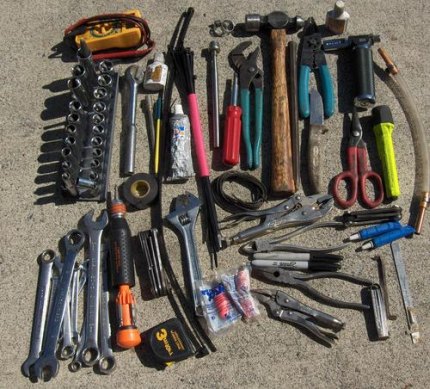
Fixing hardware usually comes with plumbing, you do not need to buy them. You should also take care of the presence of water hoses and sewer pipes for connecting the toilet to the communications.
Tile and plumbing preparation
Before mounting the toilet on the tile, the installation site must be cleaned. The presence of sand, earth, solid dust particles between the floor and plumbing can lead to a constant crunch when using the device.
Therefore, before installing, wipe the tile clean and check with your hand for any protruding elements.
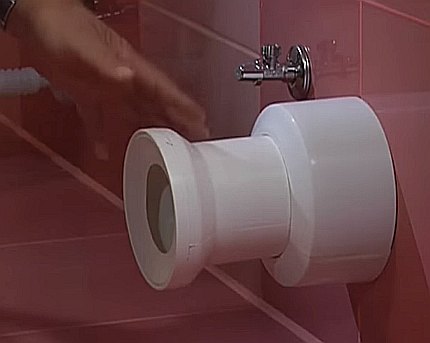
In the presence of roughness of the floor, you can gently wipe them with sandpaper or knock down with a chisel, but such a need arises infrequently.
Since the back of the toilet is installed close to the wall, it is necessary to take care of bringing the sewage system to the installation site in advance. The plumbing drain should be at a level higher than the inlet of the sewer pipe so that the water does not stagnate in the connecting fitting.
As an adapter, you can use plastic products or corrugation. Ideally, the toilet outlet is directly inserted into the sewer pipe.
Step-by-step installation of a toilet on a tile
Starting to install the toilet on the tile, you need to determine the method of fastening it. The device can be fixed in three ways: glue, bolts, using the bracket. Next, all options with the corresponding photo materials will be considered.
Bolted to the floor
The type of toilet attachment is determined by its design. To fix the device directly to the floor, special through holes are provided. The sequence of steps for installing a toilet bowl on a tile with bolts consists of several steps.
Step 1: hole marking. It is carried out on both sides by rotational movements of a pencil or marker in the corresponding hole in the toilet. It is also necessary to make several marks at the edges in order to subsequently accurately place the device in place.
Step # 2: drilling the floor. First, a notch on the tile is made in the center of the proposed hole with a core and hammer to better position the drill. Then you can start drilling. First, a gimlet is used in the form of a feather for ceramic tiles, and after penetrating through it - a drill bit for concrete.
Step # 3: intermediate cleaning of the workplace. To suck out drilled dust from the holes, it is better to remove it with a vacuum cleaner.
Step # 4: Insert dowels. They should be firmly and without hanging fixed in the floor. It is undesirable to use products less than 8 mm in diameter, because they can stick out during the operation of plumbing.
Step # 5: driving dowels. Their top edge should be below the level of the tile so that the toilet is directly on the floor. For driving it is advisable to use a mallet, but you can do this with a hammer.
Step # 6: silicone application. The sealant is extruded with a strip of 3-5 mm onto the lower edge of the toilet bowl or to an appropriate place on the tile. Its excess can be removed subsequently with a rubber spatula.
Step # 7: Putting the toilet seat in place and fixing it. A rubber gasket must be present between the bolt and porcelain so as not to split the toilet bowl when tightened. The twisting force is applied so that the device does not stagger during use. It is better to tighten the bolt later than to split the toilet bowl with extra pressure. Decorative caps are worn on top of the hats at the end.
Direct connection to the sewer done carefully so as not to grease the sealant from the bottom of the device.
Step # 8: remove excess silicone. The sealant protruding from under the lower edge is removed with a rubber spatula. In the presence of holes, you can cover them with the resulting excess.
Installation is completed, it remains only to connect pipes and hoses. If the toilet is located close to the wall, then before installation, you can attach a drain tank to it. This will save time and eliminate the need to perform work in tight spaces.
Fixing the toilet to the hidden bracket
Some manufacturers with a design purpose make the side walls of the toilet even. This makes its shape more classic and eliminates the need to wipe the dirt in the side recesses.
Such toilets are attached to hidden brackets that are pre-screwed to the floor. The following is a step-by-step instruction for this process.
Step 1: hole marking. Initially, the toilet flips over and brackets are tried on. Then the plumbing is placed on the floor and a pencil on the tile marks the place opposite the mounting holes. Then the brackets on the marks are placed on the floor and designated places for drilling.
Steps # 2-5 identical to the above steps when fastening the toilet to the floor with bolts.
Step # 6: screw the brackets to the tile at the intended level.
Step # 7: Putting silicone on the tile or bottom edge of the toilet.
Step # 8: Plumbing installation in a previously marked place.
Step # 9: fixing the toilet. Bolts inserted through the side holes, the device is attached to the brackets. Decorative caps can be included, which are then worn on screw caps.
Step # 10: remove excess silicone with a rubber spatula and cover the gaps between the floor and the toilet with a sealant.
After completing work, allow the sealant to dry.
Mostly plastic brackets come with the toilet bowl, which do not provide rigid fixation. Therefore, it is important that the device is installed on a perfectly flat surface, then it will not stagger and shift to the sides.
Installation without dowels
Sometimes drilling tiles in the bathroom is not possible, and the toilet is fixed with glue or liquid nails. Such a situation can arise when installing a heating system in the toilet in the form of a heated floor or when the plumbing is planned to be moved to another place.
For gluing to the tile, only toilet bowls with a large sole area are suitable. Therefore, it is necessary to determine the method of fixing the device before buying it.
Install the toilet on a tile without bolts using the following steps.
Step 1: marking the location of plumbing. The toilet is placed in a constant place and is circled around with a pencil or marker. Then the device is removed.
Step # 2: preparing the floor. The smooth ceramic surface of the tile has poor adhesive properties, therefore, to increase adhesion, it is recommended to process the floor at the contact point with sandpaper. After that, the surface is thoroughly washed and dried.
To prevent smearing tiles with glue, ordinary tape is glued along the outer edge of the outlined contour.
Step # 3: application of a bonding agent.As a means of fixation can be used:
- epoxy adhesive;
- adhesive mixture for tiles;
- liquid Nails.
The tool is applied with a thickness of 3-4 mm on the maximum possible area of the sole. If the bottom surface of the toilet bowl has a simple shape, then the adhesive can also be applied to the tiles in the appropriate place.
Step # 4: Installing the toilet on the floor. The plumbing fixture placed on the tile is pressed strongly, after which adhesive tape is peeled off from the tile, and excess glue along its edges is removed with a spatula.
The installed toilet should not be touched during the day until the fastener is completely dry.
The bonding strength with epoxy adhesive is comparable to installing plumbing with bolts. And when disconnected from the floor, the device can always be easily re-glued.
Installing the rest of the toilet system
The algorithm for installing plumbing in the toilet may vary, depending on the device equipment and its layout.
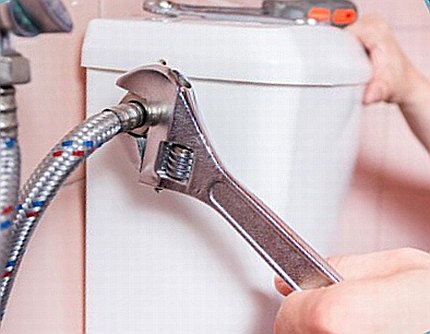
After fixing the toilet bowl to the tile, the following sequence of actions is possible:
- Connecting the toilet to the sewer with a direct connection using a corrugation or knee.
- Installing a drain tank and connecting it to the water supply system.
- Testing the work of plumbing, leak detection.
- Lid mount.
After successful completion of work, you can use the toilet for years without worrying about the need for repairs.
When loosening the fixture and the appearance of a staggering device, you can always tighten the bolts with a wrench, pressing the plumbing stronger to the floor.
We also recommend that you read the material, where we compared all the advantages and disadvantages of various ways of fixing the toilet to the floor. Read more - read Further.
Conclusions and useful video on the topic
The presented videos on fixing the toilet bowl to the tile and sealing its lower sole will help ensure the ease of use of plumbing.
Installing a side-mounted toilet:
Installing a toilet bowl on a tile with bolts:
Technique for sealing the gap between the toilet and the floor:
In independent mounting toilet on the tile there is nothing complicated. It is enough to have the necessary tool and an hour of time. And after installing the plumbing on the floor, a more difficult stage is ahead - installing the tank and connecting the entire system to plumbing communications. This will require much more time and patience.
Trying to install the toilet on the tile yourself and have difficulties? Or do you already have experience in carrying out such work and can you give practical advice to our readers? Please leave comments, share experiences, ask questions in the block below.

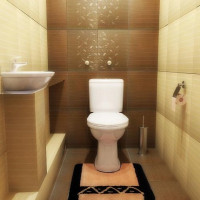 How to install a toilet with an oblique outlet: detailed technical instructions
How to install a toilet with an oblique outlet: detailed technical instructions 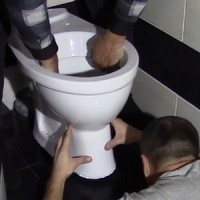 Do-it-yourself toilet installation: features of mounting toilet bowls of various designs
Do-it-yourself toilet installation: features of mounting toilet bowls of various designs 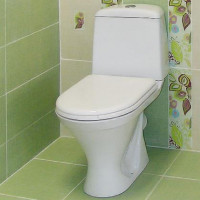 How to install a toilet on a tile: an overview of the best ways and technical nuances
How to install a toilet on a tile: an overview of the best ways and technical nuances 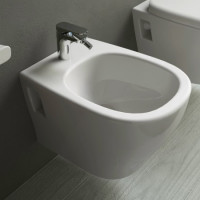 DIY bidet installation: specifics of installation and connection to communications
DIY bidet installation: specifics of installation and connection to communications 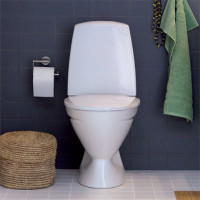 How to fix the toilet to the floor: an overview of the technical details and the best installation methods
How to fix the toilet to the floor: an overview of the technical details and the best installation methods 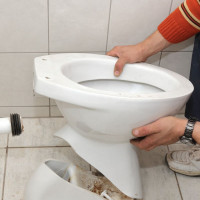 How to replace the toilet: step-by-step instruction on how to replace the toilet with your own hands
How to replace the toilet: step-by-step instruction on how to replace the toilet with your own hands  How much does it cost to connect gas to a private house: the price of organizing gas supply
How much does it cost to connect gas to a private house: the price of organizing gas supply  The best washing machines with dryer: model rating and customer tips
The best washing machines with dryer: model rating and customer tips  What is the color temperature of light and the nuances of choosing the temperature of the lamps to suit your needs
What is the color temperature of light and the nuances of choosing the temperature of the lamps to suit your needs  Replacement of a geyser in an apartment: replacement paperwork + basic norms and requirements
Replacement of a geyser in an apartment: replacement paperwork + basic norms and requirements
From my own experience (sad) I’ll say: if you plan to install the toilet, as I did, without screwing it on an adhesive, wait until there is no one at home (at least during the day). I put the toilet at home, warned everyone - do not touch the day! But there were figures who simply forgot ... and took advantage of the night ... 🙂 in the end I had to start everything from scratch.
Putting on glue is not a good idea. Well, or I was not lucky with glue, but a year later, the toilet began to “walk” from side to side when they sat on it. I had to remove, clean everything, glue again. While it’s standing, but if it loosens again, they will already put it on the bolts, it’s more reliable. The only thing I'm afraid of because of the bolts is that I will fail to drill and the tile will crack.